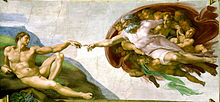Lateral sulcus
The cerebral cortex was not depicted in a realistic manner until the 17th century with the Sylvian fissure being first accurately painted by Girolamo Fabrici d'Acquapendente in 1600 to provide plates for his Tabulae Pictae.[4][5][6] Its first description is traditionally taken to be in 1641, possibly by Caspar Bartholin, where its discovery was attributed to Franciscus Sylvius (1614–1672), professor of medicine at Leiden University in the book Casp.[4] Pop musician David Bowie referred to psychologist Carl Jung as "...crashing out with Sylvian" in his lyrics to "Drive-In Saturday" released on his 1973 album Aladdin Sane.In 2015,[7] artist Tanja Stark suggested Bowie had drawn a cryptic link between Jung's waking hallucinatory visions (see The Red Book) and the Sylvian fissure, a region discovered by that time to produce hallucinogenic visions and ‘paranormal’ perceptions when electrically stimulated and, presciently in 2006, to generate what neurologists called an ‘illusory shadow person’ or doppelgänger phenomenon; themselves highly charged and recurring Bowie archetypes (Penfield [8] 1955; Arzy et al., 2006[9]).You Pretty Things" sings of the hallucinatory spectre of .."a crack in the sky and a hand reaching down to me", evoking the iconic imagery of Michelangelo's painting The Creation of Adam.


NeuroNamesNeuroLexAnatomical terms of neuroanatomyFranciscus Sylviussulcuscerebral hemispherehuman brainfissurefrontalparietal lobestemporal lobeinsular cortexfrontal lobeparietal lobehemispheres of the braingestational ageinferior frontal gyrustransverse temporal gyriauditory cortexYakovlevian torqueSylvian pointsecondary somatosensory cortexGirolamo Fabrici d'AcquapendenteCaspar BartholinLeiden UniversityThomas BartholinDavid BowieCarl JungDrive-In SaturdayThe Red BookdoppelgängerOh! You Pretty ThingsThe Creation of AdamMichelangelouterusumbilical cordAnnals of NeurologyMayo Clinic Proceedingscerebral cortexPrefrontalSuperior frontal gyrusMiddle frontal gyrusPars orbitalisBroca's areaPars opercularisPars triangularisSuperior frontal sulcusInferior frontal sulcusPrecentralPrecentral gyrusPrecentral sulcusMedial frontal gyrusParaterminal gyrusParaolfactory areaStraight gyrusOrbital gyriOrbitofrontal cortexVentromedial prefrontal cortexSubcallosal areaOlfactory sulcusOrbital sulcusParacentral lobuleParacentral sulcusPrimary motor cortexPremotor cortexSupplementary motor areaSupplementary eye fieldFrontal eye fieldsSuperior parietal lobuleInferior parietal lobuleSupramarginal gyrusAngular gyrusParietal operculumIntraparietal sulcusPrecuneusMarginal sulcusPostcentral gyrusPrimary somatosensory cortex3, 1 and 2Posterior parietal cortexOccipital lobeOccipital gyriLateral occipital gyrusLunate sulcusTransverse occipital sulcusVisual cortexCuneusLingual gyrusCalcarine sulcusTransverse temporal gyrus41 and 42Superior temporal gyrusWernicke's areaPlanum temporaleSuperior temporal sulcusMiddle temporal gyrusOccipitotemporal sulcusFusiform gyrusMedial temporal lobeInferior temporal sulcusInferior temporal gyrusInterlobarsulci/fissuresCentral (frontal+parietal)Parieto-occipitalPreoccipital notchLongitudinal fissureCingulate (frontal+cingulate)Collateral (temporal+occipital)Callosal sulcusLimbic lobeParahippocampal gyrusEntorhinal cortexPerirhinal cortexPostrhinal cortexPosterior parahippocampal gyrusPrepyriform areaCingulate cortexSubgenual areaAnterior cingulatePosterior cingulateIsthmus of cingulate gyrusRetrosplenial cortexHippocampal formationHippocampal sulcusFimbria of hippocampusDentate gyrus